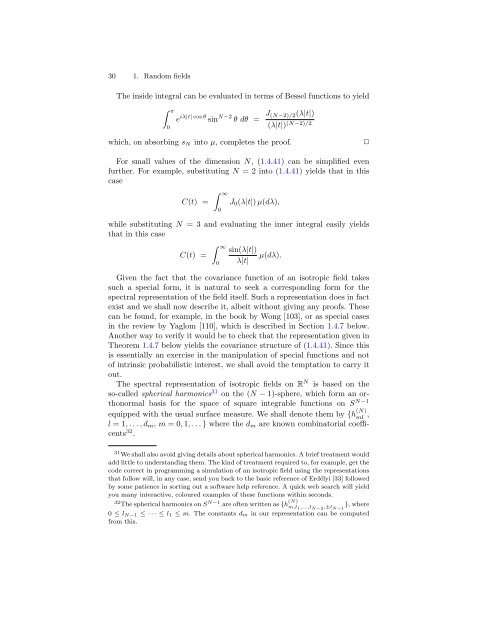You also want an ePaper? Increase the reach of your titles
YUMPU automatically turns print PDFs into web optimized ePapers that Google loves.
30 1. Random fields<br />
The inside integral can be evaluated in terms of Bessel functions to yield<br />
� π<br />
0<br />
e iλ|t| cos θ sin N−2 θ dθ = J (N−2)/2(λ|t|)<br />
(λ|t|) (N−2)/2<br />
which, on absorbing sN into µ, completes the proof. ✷<br />
For small values of the dimension N, (1.4.41) can be simplified even<br />
further. For example, substituting N = 2 into (1.4.41) yields that in this<br />
case<br />
C(t) =<br />
� ∞<br />
0<br />
J0(λ|t|) µ(dλ),<br />
while substituting N = 3 and evaluating the inner integral easily yields<br />
that in this case<br />
C(t) =<br />
� ∞<br />
0<br />
sin(λ|t|)<br />
λ|t|<br />
µ(dλ).<br />
Given the fact that the covariance function of an isotropic field takes<br />
such a special form, it is natural to seek a corresponding form for the<br />
spectral representation of the field itself. Such a representation does in fact<br />
exist and we shall now describe it, albeit without giving any proofs. These<br />
can be found, for example, in the book by Wong [103], or as special cases<br />
in the review by Yaglom [110], which is described in Section 1.4.7 below.<br />
Another way to verify it would be to check that the representation given in<br />
Theorem 1.4.7 below yields the covariance structure of (1.4.41). Since this<br />
is essentially an exercise in the manipulation of special functions and not<br />
of intrinsic probabilistic interest, we shall avoid the temptation to carry it<br />
out.<br />
The spectral representation of isotropic fields on R N is based on the<br />
so-called spherical harmonics 31 on the (N − 1)-sphere, which form an orthonormal<br />
basis for the space of square integrable functions on S N−1<br />
equipped with the usual surface measure. We shall denote them by {h (N)<br />
ml ,<br />
l = 1, . . . , dm, m = 0, 1, . . . } where the dm are known combinatorial coefficents<br />
32 .<br />
31 We shall also avoid giving details about spherical harmonics. A brief treatment would<br />
add little to understanding them. The kind of treatment required to, for example, get the<br />
code correct in programming a simulation of an isotropic field using the representations<br />
that follow will, in any case, send you back to the basic reference of Erdélyi [33] followed<br />
by some patience in sorting out a software help reference. A quick web search will yield<br />
you many interactive, coloured examples of these functions within seconds.<br />
32 The spherical harmonics on S N−1 are often written as {h (N)<br />
m,l1,...,l N−2,±l N−1 }, where<br />
0 ≤ lN−1 ≤ · · · ≤ l1 ≤ m. The constants dm in our representation can be computed<br />
from this.
















